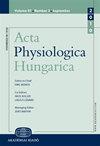Characteristics of cardiorespiratory output determining factors among 11-19-year-old boys at rest and during maximal load: Its impact on systolic hypertension.
引用次数: 1
Abstract
As consequence of the expansion of sedentary lifestyle among schoolchildren the prevalence of particular symptoms related to decreased cardiorespiratory fitness increases. The purpose of this study was twofolds, on one hand to compare boys in three developmental groups: second childhood (G1), puberty (G2), young adult (G3) and on the other hand to compare groups classified on resting systolic blood pressure (RSBP) to differentiate cardiorespiratory output determining factors both at rest and at maximal load. Randomly selected apparently healthy boys were assessed, all subjects (n = 282) performed an incremental treadmill test until fatigue. Heart rate (HR), systolic and diastolic blood pressure (SBP and DBP), and oxygen consumption were measured. Resting HR was higher and resting SBP and DBP were lower in the G1 as compared to G2 and G3 (p < 0.05) but not differed at maximal loads. However indicators of cardiovascular load differed between groups. The oxygen pulse and Q were the lowest in the G1 and increased significantly between groups (p < 0.05). In conclusion based on our data we can suggest that there is an observable development of hypertension associated with maturation and cardiac output determining factors.11-19岁男孩休息和最大负荷时心肺输出量决定因素的特点:对收缩期高血压的影响。
由于在校学生中久坐生活方式的扩大,与心肺功能下降有关的特定症状的患病率增加。本研究的目的是双重的,一方面比较男孩的三个发育组:第二童年(G1)、青春期(G2)、青年期(G3),另一方面比较按静息收缩压(RSBP)分类的组,以区分静息和最大负荷时的心肺输出量决定因素。随机选择明显健康的男孩进行评估,所有受试者(n = 282)进行渐进式跑步机测试直到疲劳。测量心率(HR)、收缩压和舒张压(SBP和DBP)、耗氧量。与G2和G3相比,G1组的静息心率更高,静息收缩压和舒张压更低(p < 0.05),但在最大负荷下无差异。然而,心血管负荷指标在两组之间存在差异。氧脉冲、Q值在G1期最低,组间差异有统计学意义(p < 0.05)。总之,根据我们的数据,我们可以认为高血压的发展与成熟和心输出量的决定因素有关。
本文章由计算机程序翻译,如有差异,请以英文原文为准。
求助全文
约1分钟内获得全文
求助全文

 求助内容:
求助内容: 应助结果提醒方式:
应助结果提醒方式:


